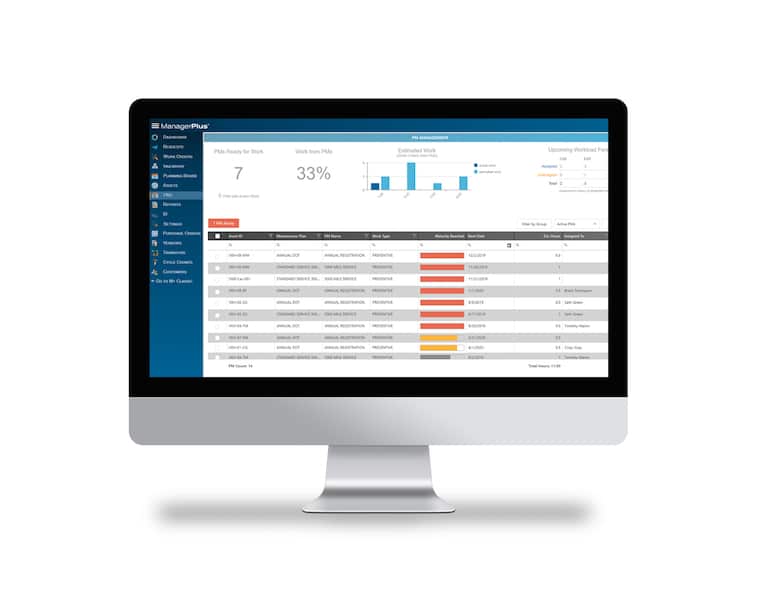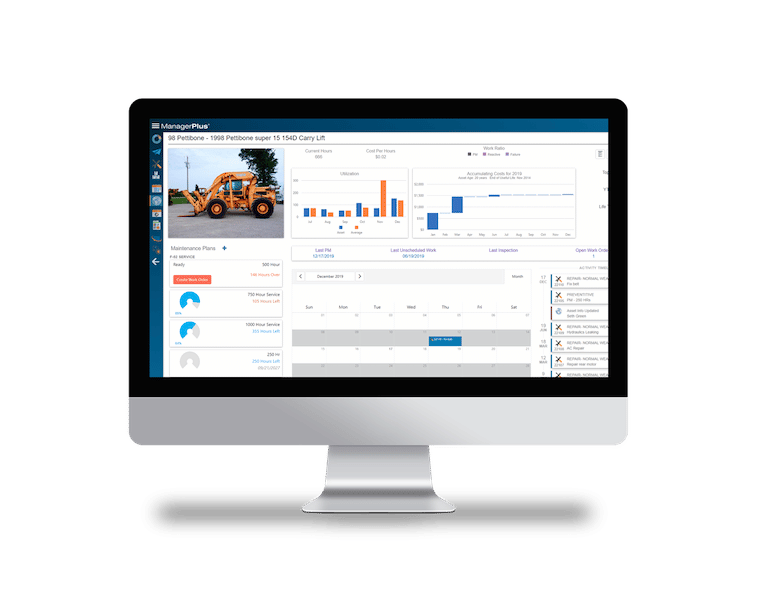As your portfolio of assets expands, equipment maintenance becomes increasingly complex.
In one study, analyst firm Aberdeen reported unplanned downtime costs companies as much as $250,000 per hour. These costs add up as technicians spend valuable time working to identify the problem, searching for parts, and making repairs to bring equipment back to the production line as soon as possible.
These six strategies will help you make the most of your equipment, vehicles, and more.
Proactive equipment maintenance can help you avoid downtime, maintain productivity, and keep customer relationships strong.
Essential equipment maintenance strategies
1. Develop a comprehensive preventive maintenance program
You’re already well aware of the benefits of preventive maintenance, but your team may still struggle to perform PM tasks efficiently. You may have a never-ending backlog of work orders that your technicians never seem to have time to address.
Unless you’re scheduling preventive maintenance activities in advance and holding everyone accountable for completing them, they will never be a priority. They’ll remain on that “important but not urgent” list until a piece of equipment actually fails — always at the worst possible time.
A documented preventive maintenance program can significantly improve equipment performance and extend the life of your heavy machinery.
First, you need to determine which assets are most critical or prone to predictable failures, and determine the triggers for preventive maintenance tasks. Generally, these are meter- or time-based conditions such as hours worked.
Once you identify these triggers based on a combination of the manufacturer’s recommendations and your team’s in-house experience, you can use preventive maintenance software to schedule tasks in advance.

Along with improving equipment reliability, preventative maintenance programs help you retain records of past inspections and services. This makes it easy to access them for compliance audits.
These detailed records can be used to generate reports based on key performance indicators (KPIs) for your asset to help your team make more informed decisions about whether it’s more cost-effective to continue to repair certain assets or replace them.
2. Properly train equipment operators
One of the most important ways to protect your equipment and your crew is to make sure anyone who operates your equipment is fully trained and up-to-date on their certifications. This may seem like common sense, but operator error is one of the three most common causes of equipment failure, according to the ARC Advisory Group.
Not only is having untrained workers dangerous, it can also result in hefty fines or legal action.
It’s important to document all training and certifications in a digital, cloud-based platform so you can make note of when certifications are set to expire to keep everyone on your team up to date.
You also need to make sure that everyone on your team has access to digital copies of important equipment details and instructions from their mobile devices. Forcing an operator to hunt for a physical manual or safety guideline when they have a question leads to unnecessary downtime.
3. Update and upgrade assets on schedule
When a piece of equipment has been working long past its expected useful life, the probability that it will fail becomes much higher. Old and outdated assets are statistically prone to breakdowns.
Keeping assets from malfunctioning and derailing operations requires upgrading parts or entire machines. Pushing an asset beyond its intended run times in an attempt to save some money usually ends up costing you much more than it would have when it fails than if it had been updated or upgraded when it was supposed to be.
The best way to overcome this problem is to have a planned asset upgrade schedule, similar to your planned maintenance schedule. The right enterprise asset management (EAM) software helps you determine this by tracking assets throughout their life cycle. For each asset you can see purchase dates, maintenance records, inspections, and failures to help you know when it’s time to update or replace it.

5. Improve inspection accountability
Performing complete, consistent inspections helps your team identify potential failures before they lead to equipment downtime.
Unfortunately, even large enterprises with advanced technology still rely on paper-based inspections. This can lead to operators simply checking boxes so they can get on with their day.
Mobile inspections improve accountability by requiring operators to verify asset status with simple pass/fail buttons. They can also select from pre-populated failure codes to alert the maintenance team of any issues immediately. These failure codes make it easier to categorize the causes of equipment downtime so your team can determine more proactive ways to reduce it.
As you conduct equipment inspections, pay close attention to conditions that may indicate potential failure, such as:
- Battery life
- Engine components
- Fluid levels
- Friction
- Temperature fluctuation
- Worn treads or low tire air pressure
- Vibration
- Worn or broken belts
Condition-based maintenance can involve using sensors to monitor certain elements inside machines or simply conducting visual inspections.
6. Track equipment metrics to justify future investments
A few hours of downtime on occasion may not seem like it has much of an impact on your overall operations, but it adds up fast. According to downtime consultants, 80% of manufacturing companies can’t accurately estimate their downtime costs. Those that can underestimate downtime by 300%.
To justify future expenditures that increase reliability, it’s important to calculate the total cost of equipment downtime.
To get the most accurate estimate, there are several different equipment metrics you need to monitor.
Lost time is a percentage of time an asset is down compared to the total time it’s in use.
Lost revenue is a calculation of the revenue generated by each piece of equipment per hour, multiplied by the number of hours it is down.
You also need to identify your mean time to repair (MTTR), or the amount of time it takes to bring equipment back online. If your team is taking a long time to assign work orders, diagnose failures, and repair assets, you need to determine why.
How equipment management software can help
Do you have an inefficient process for communicating failures to the maintenance team and prioritizing tasks?
Is your team spending too much time searching for parts due to poor inventory management?
Maybe you have a few experienced maintenance veterans who haven’t been able to effectively transfer their knowledge to newer, less-experienced team members.
Equipment management software, also known as enterprise asset management software, is a comprehensive platform that includes everything you need to fix these problems and reduce downtime.
You can track assets throughout their life cycle, schedule preventive maintenance, perform inspections, and manage inventory.
You can also use maintenance and inspection records to conduct a detailed failure analysis, allowing you to anticipate and prevent the most common issues that lead to equipment downtime.
Whether you spend most of your time on the road, at a construction site, on the factory floor, or managing buildings, you need your assets to work as hard as you do.
Investing in equipment management software now can save your organization thousands of dollars each year. When you reduce equipment downtime, you control costs and improve profitability by ensuring smooth operations and satisfied customers.
ManagerPlus Lightning brings all this functionality into one, user-friendly system your team can use anywhere. Operators can conduct mobile inspections before they start their shift, while maintenance technicians can receive instant alerts when something needs to be repaired. Executives and asset managers can see detailed reports that give them deeper insight into the total cost of ownership and the most common causes of equipment failures. With this insight, they can make better decisions about future investments.
To see Lightning in action, schedule a demo today.

